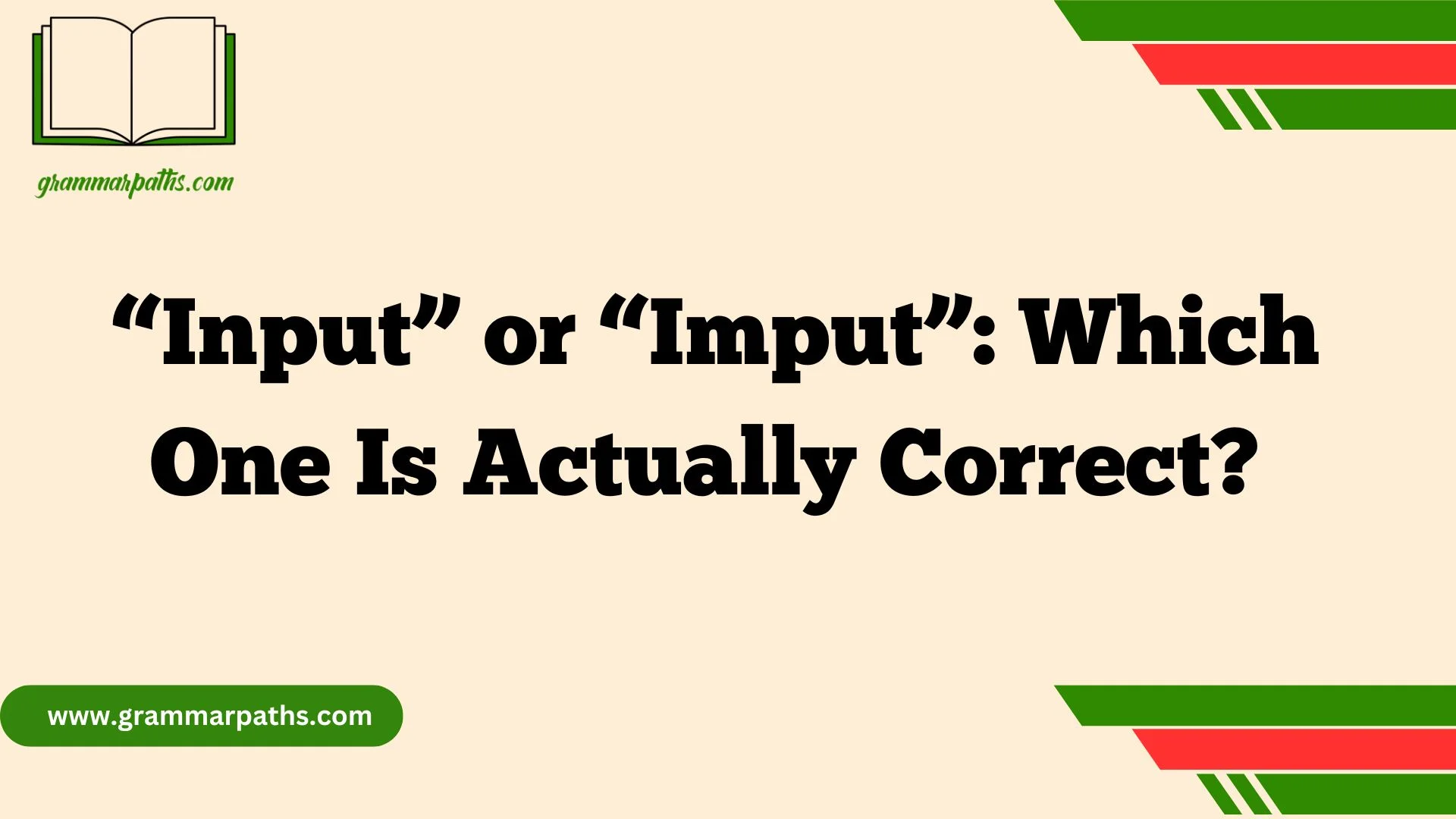Have you ever typed the word “imput” in an email or heard someone say it during a meeting and thought, “Wait, is that right?” You’re not alone. The confusion between input vs imput is surprisingly common, especially in fields like communication and technology where these terms are used frequently. Here’s the truth: “imput” is simply a misspelling. The correct word is “input”, and knowing the difference can make a real impact on how clearly and professionally you communicate.
Input is a real, meaningful word—used to describe information, data, ideas, or feedback that’s given or entered into a system. It’s common in tech, business, and day-to-day conversations. Think of examples like “Thank you for your input,” or “The system requires user input.” Meanwhile, “imput” isn’t a valid English word at all—just a spelling error that sneaks in through fast typing, autocorrect, or simple confusion. But in professional writing, even small spelling mistakes like this can chip away at your credibility.
This article will help you avoid that slip-up for good. We’ll break down the correct usage of input, explain why “imput” shows up so often, and offer tips for remembering the right spelling. Whether you’re writing emails, giving feedback, or working with input and output systems, understanding this word will sharpen your communication and boost your confidence in every message you send.
Quick Summary:
The word “imput” is a common misspelling of the correct term “input”, which refers to information, feedback, or data entered into a system. This mix-up often occurs in communication and technology contexts due to fast typing or autocorrect. While input is widely used in professional settings, using imput can hurt your credibility. This article explains the correct usage of input, why imput keeps appearing, and how to avoid this common spelling mistake to improve clarity and professionalism in your writing.
Quick Answer — “Input” Is Correct
Let’s get straight to the point:
- ✅ Input is the correct spelling.
- ❌ Imput is a common misspelling and not recognized in standard English dictionaries like Merriam-Webster or Oxford.
If you’ve seen or typed “imput”, it’s likely just a typo or a result of phonetic confusion. Stick with input in every formal or informal setting.
What Does “Input” Mean?
The word input has multiple meanings, depending on context. Let’s explore its usage across various fields.
General Definition
Input refers to information, data, advice, or material that is put into something for processing, discussion, or decision-making.
Usage Across Different Fields
| Context | Meaning | Example |
| Technology | Data entered into a system or device | “The user input was stored in the database.” |
| Communication | Feedback, ideas, or contributions from people | “Your input on this project is highly valuable.” |
| Engineering | Material, energy, or signals fed into a system | “The machine’s input determines the output rate.” |
| Economics | Resources (land, labor, capital) used in production | “Labor is a primary input in any production line.” |
Input as a Verb
Input can also be used as a verb, especially in technical settings:
- Example: “She input the data manually.”
(Here, it means to enter data into a computer or database.)
Why Do People Mistakenly Say or Type “Imput”?
This confusion doesn’t come out of nowhere. Here’s why it happens:
Phonetic Confusion
- When spoken quickly, “input” can sound like “imput”, especially in non-rhotic accents (where the “r” sound isn’t pronounced).
- In regional dialects or casual speech, the blending of sounds can make “input” seem like it ends with a “t”.
Common Typing Errors
- Keyboard layout proximity: “m” is next to “n”.
- Speed-typing often causes small but impactful typos.
- Voice-to-text software sometimes mishears and autocorrects to “imput.”
Habitual Misspelling
- If someone learns the incorrect spelling early on, they’re likely to repeat it—especially if spellcheck doesn’t flag it immediately.
Is “Imput” Ever Used in Any Language or Field?
In standard English usage, imput is not an accepted word.
Exceptions or Rare Appearances
- You might stumble upon imput in:
- Poorly translated texts
- Mistyped documents
- Low-quality web pages or AI-generated spam
- Poorly translated texts
However, it’s never correct in academic, professional, or formal communication.
✅ If you’re writing in English, always use “input.”
Grammar and Usage Tips for “Input”
Is “Input” Singular or Plural?
The word input can be used both ways:
- Mass noun (uncountable):
- “She gave helpful input during the meeting.”
- “She gave helpful input during the meeting.”
- Countable noun (when discussing multiple sources or types):
- “We received three different inputs from stakeholders.”
- “We received three different inputs from stakeholders.”
Plural Form
- The plural is inputs.
- “All data inputs were recorded accurately.”
- “All data inputs were recorded accurately.”
Input as a Verb
- Present: input
- Past: both input and inputted are correct (though “input” is more commonly used in tech).
- “He input the numbers yesterday.”
- “She inputted her credentials incorrectly.”
- “He input the numbers yesterday.”
Avoiding Redundancy
Don’t say: “Input in data.”
Instead say: “Input data” — the verb already implies entering into.
Common Misspellings Similar to “Imput”
Here’s a list of frequent spelling mistakes and how to avoid them:
| Incorrect Spelling | Why It’s Wrong | Correction |
| Imput | Not a valid English word | Input |
| Inpit | Typo from rushed typing | Input |
| Impoot | Confused vowel usage | Input |
| Enput | Misheard pronunciation | Input |
| Inbut | Letter swap | Input |
How to Avoid These Mistakes
- Use browser-based spellcheckers like Grammarly.
- Read your text out loud—you’ll spot odd-sounding errors.
- Slow down during proofreading, especially in important documents.
“Input” in Real Sentences
Let’s look at some practical usage examples.
In Casual Conversations
“Hey, I’d love your input on the color scheme.”
In Business Meetings
“The client’s input helped shape the marketing strategy.”
In Software Development
“The form requires user input before submission.”
In Academic Research
“We analyzed multiple inputs from different variables.”
In Engineering
“The system processes raw material inputs into usable goods.”
How to Remember the Right Word
If you often get tripped up, here are some memory tricks:
Mnemonic Device
“Information is put into the system” = Input
Visual Diagram Suggestion
css
CopyEdit
[ User ] ➜ [ Input ] ➜ [ System ] ➜ [ Output ]
Imagine a machine. You give it input, it processes, and gives back output.
Quick Rhyme
“To get it right, input’s tight — don’t mix up that spelling fight.”
Think Tech
If you work with computers, remember:
- Keyboard input
- Mouse input
- Data input
You’ll never see “imput” in real code or documentation.
Quiz: Test Your Knowledge
Choose the correct version in each sentence.
- “Please provide your [input / imput] before we proceed.”
- “He [input / imput] the wrong password.”
- “Multiple data [inputs / imput] are required for accuracy.”
- “Her [input / imput] during the session was insightful.”
- “The user [inputted / imputed] the final scores.”
Answers:
- Input
- Input
- Inputs
- Input
- Inputted
Frequently Asked Questions
Is it input or inputted?
Both “input” and “inputted” are grammatically acceptable past tense forms. However, “input” is more commonly used in modern English, especially in technical or computer-related contexts.
What is a good sentence for input?
Here’s an example: “The teacher asked for student input before making changes to the syllabus.” This sentence shows how “input” can mean suggestions, feedback, or opinions.
What is the opposite of input?
The opposite of input is typically output. While input refers to data or ideas going in, output refers to the result or product that comes out of a process or system.
Is input a real word?
Yes, input is a real and widely used word in English. It refers to anything that is put into a system—whether it’s data, information, energy, or even feedback.
Does input mean opinion?
Yes, in certain contexts, input can mean opinion or feedback. For example, when someone asks for your input on a decision, they’re requesting your thoughts or viewpoint.
Final Thoughts:
In conclusion, the word ✅ “input” is the only correct spelling in the English language. Whether you’re referring to data entered into a system, user feedback, or information processing, “input” is the standard across both professional writing and technical fields. The variant “imput” is a frequent typo or phonetic error, often made during fast typing or due to mishearing the word.
Understanding the correct usage of “input” enhances not only your communication skills but also your credibility in any setting—from business documents and coding environments to everyday conversations. Being mindful of these common spelling pitfalls helps maintain a clear, polished, and professional tone in your writing.
So next time you’re typing up a report or chatting in a tech forum, remember: “input” is the right choice, and “imput” doesn’t belong in your vocabulary. Small details like this might seem minor, but they play a big role in ensuring your message is accurate and respected. Stick with the correct form, and you’ll never have to second-guess yourself again.

Emma Brooke is a passionate language expert and contributor at GrammarPaths.com, where she helps learners navigate the complexities of English grammar, idioms, and effective writing. With a strong academic background and years of teaching experience, Emma excels at turning tricky grammar rules into simple, practical lessons that readers can easily grasp.












